We had a fantastic response for our call for questions to the Reaction Engines team working on Skylon and its propulsion system, the SABRE engine. We collated your questions, sent them to Culham, and the RE team have kindly supplied answers. We’ll be continuing to cover Skylon, and hope to feature an update on the engine testing programme soon.
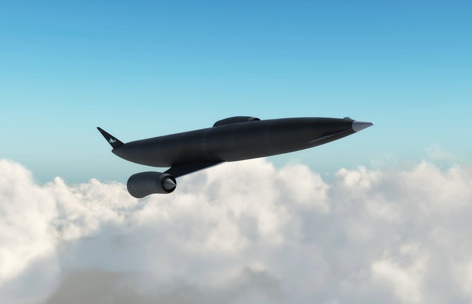
What additional technical challenges are presented by the deep cryo precooler tests, as opposed to the “warm” cryogenic tests that have been performed to date?
Suggested by Duncan Law-Green
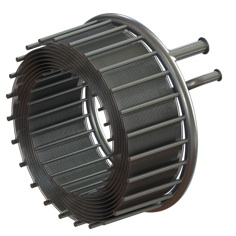
To date over 200 pre-cooler test runs of varying purpose and duration have been undertaken, including sustained sub-zero operation of the pre-cooler for time periods in excess of six minutes. As part of this testing process we have had to address several technical challenges associated with the test rig (i.e. the equipment that we use to provide the pre-cooler with the desired operating conditions for a given test) but the pre-cooler itself continues to meet expectations and has proved to be robust. The items on the test rig equipment that have required rework were not meeting expectations due to the impact of the unique operating conditions, including very high pressures and very low temperatures.
As stated in our most recent press release the next phase of testing includes deep-cooling of the incoming airflow to -150 degrees Celsius. We are not able to discuss the testing in detail but we do not anticipate any significant additional challenges beyond those already experienced in the test rig, though of course any engineer will tell you there can be surprises. Most importantly we will continue to gather large amounts of data relating to the operation of pre-coolers. We will provide an update on the testing in due course.
Robert Bond, Corporate Programmes Director
What work are you doing on other aspects of the engine besides the pre-cooler technology and how is this progressing?
(Suggested by Daniel Yount)
The SABRE engine at its most basic level can be seen as a combination of established jet and rocket technology, the marriage of which is made possible by the introduction of new technologies such as the light-weight heat exchangers. REL has focused on demonstrating these new technologies within the engine in order to raise the technology readiness level of the SABRE engine as a whole. The technology demonstrations also provide data to validate the engine modelling. Alongside the pre-cooler and frost control, technology demonstrations have been undertaken in areas including:
- engine intake aerodynamics using wind tunnel testing
- contra-rotating turbines for the helium loop
- combustion chamber cooling using liquid oxygen and hydrogen film cooling
- altitude compensating nozzles to further increase engine performance
- pre-cooler installation aerodynamics
- development of other light-weight heat exchangers needed within the SABRE engine
- engine igniters
- low NOX combustors for atmospheric cruise applications
This work has been progressing successfully and has, along with in-depth engine cycle analysis, led us to the point where we are confident that a demonstration of the full engine cycle can be performed and this was also the conclusion of an independent technical assessment organised by the UK government.
Helen Webber, Performance Engineer
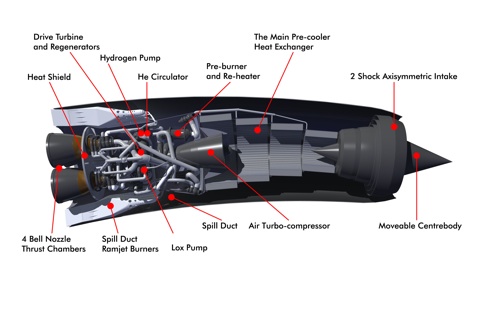
How much has the use of computer modelling/simulation aided this project - would it have been possible without it or just taken a lot longer?
(Suggested by Paul Reeves)
Computer simulation and modelling has been and will continue to be a vital component in the development of the SABRE engine and Skylon. We certainly wouldn’t recommend attempting this work without it! Of course, fundamental analysis undertaken with a pencil, physics and a back of an envelope is not forgotten and remains an invaluable tool.
We have used computer simulation across the design process from analysing aerodynamics of components through to the performance and trajectory of the Skylon/SABRE system and the re-entry of the vehicle.
Roger Longstaff, Aerospace Engineer
Assuming everything goes according to plan, how long will it be before you can test the full SABRE engine on the ground and in flight and how would you conduct these tests?
(Suggested by Andy H and Thomas Pitcher)
The SABRE engine offers an attractive development path because it is suitable for ground based test bed development. This is because the flow downstream of the SABRE engine intake is always subsonic irrespective of the speed at which the engine is flying. As a consequence it is possible to simulate the air-breathing flight conditions of the core engine up to Mach 5 on the ground prior to flight testing by appropriately heating the incoming airstream to represent high Mach flight conditions. This provides a cost advantage because it avoids costly flight tests and enables substantial development time on the engine’s core components on the test rig. The pre-cooler testing is an example of the benefits of ground based demonstrations with over 200 tests undertaken to date.
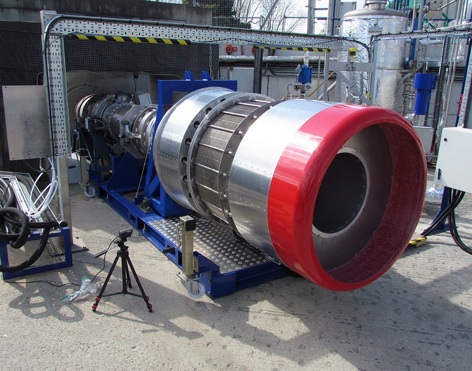
It will take approximately three years to undertake a sub-scale ground demonstration of the engine which will be used to provide data for the first full scale SABRE engine. Flight testing of engine systems will be undertaken in parallel with the ground testing in order to provide, for example, data on the nacelle supersonic and hypersonic aerodynamics.
The ground testing and flight testing of the first prototype SABRE engine would take place 2-3 years after the sub-scale ground and flight testing commences.
Robert Bond, Corporate Programmes Director
Would you be able to enlarge or improve the engine design for even bigger versions of Skylon or another craft and what would the limiting factors be?
(Suggested by Felix Schneider and Nick Cramp)
The jet engine has seen innovation and performance improvements over the many decades since its inception, for example the introduction of the single crystal turbine blade and increasing by-pass ratios. Similarly the SABRE engine is likely to see performance improvements in subsequent generations of the engine. This could include improving fuel consumption for a given thrust and increasing the engine’s top speed in air-breathing mode. REL is one of a small number of organisations to have considered the true impact of lightweight heat exchangers on aerospace and future developments could be quite exciting.
The SABRE engine is designed to meet the requirements of the Skylon system which in theory can increase or decrease in size. Factors to consider in varying the size of Skylon (and therefore SABRE) include the market requirement in terms of payload to orbit, increased development and manufacturing cost for larger vehicles, and increased payload sensitivity with smaller vehicles. As an aerospace vehicle gets smaller the payload as a percentage of take-off mass tends to reduce because some systems do not get lighter as the aircraft gets smaller. An example of this in Skylon is the aeroshell skin which cannot simply be made thinner as the vehicle decreases in size.
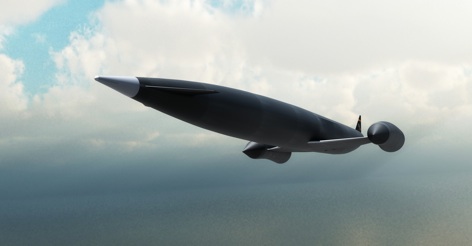
When looking at smaller SABRE engines the design approach used for some subsystems within the engine can change. For example, at small scales it may be found that an axial compressor is no longer optimal for a task and a centrifugal compressor needs to be used instead. Therefore, it is important to consider the scale of engine demonstrators and to balance attempting to reduce cost with the transferability of the lessons learned to the development of practical systems.
Richard Varvill, Technical Director
What kind of location do you imagine could be used for a Skylon spaceport in terms of its geographical position and surrounding landscape?
(Suggested by Martin)
For the operator of a Skylon vehicle the latitude of the spaceport will impact the mass that can be lifted to a given orbit. For high volume cargo flights e.g. for operators wishing to use their vehicles for large projects such as construction of space stations, large satellite constellations and interplanetary missions it would be most cost effective to use an equatorial spaceport in a remote location. We imagine that several sites would emerge around the Earth’s equator. Where the cost per mass to orbit is less critical or where polar orbits are a priority the Skylon spaceport could be located away from the equator, including in the UK.
Skylon operations will also need to comply with a variety of regulations and this will impact on the exact location. An obvious example is that the spaceports are likely to be located away from densely populated areas to avoid the impact of noise and to reduce insurance costs. The regulatory environment for Skylon is currently being explored by the UK government.
Roger Longstaff, Aerospace Engineer
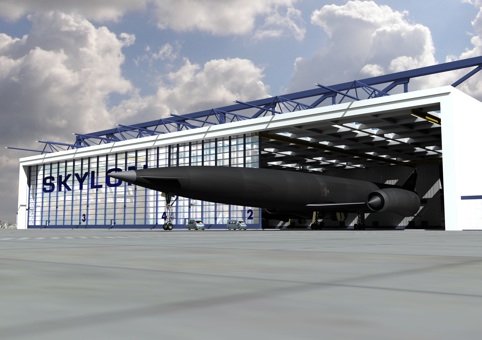
What other applications do you think your propulsion, cooling and other technology could be used for?
(Suggested by Tim Murphy, Paul Reeves and Anonymous)
There are a large number of potential and exciting applications for the SABRE engine and its enabling technologies beyond the space access market.
In terms of propulsion, the SABRE engine has derivative configurations that have been shown to be suitable for high Mach atmospheric cruise applications. One example is the Scimitar engine which was analysed as part of the joint private/EU funded LAPCAT project. It is capable of Mach 5 cruise to transport passengers and cargo around the globe with a significant reduction in journey time for long distance flights and without the necessity for mid-journey refueling. Other areas of propulsion technology include energy recovery and improved cycle efficiencies for subsonic gas turbines and higher performing exhaust nozzles for current expendable launch vehicles.
Other market applications for the technologies that we have been developing include but are not limited to improving the efficiency of ground-based heat engine cycles for power production, reducing infra-red signatures in engine exhausts, increasing the performance of automotive engines through improved waste heat recovery, higher performing air-conditioning and refrigeration systems for civil and industrial applications such as for LPG shipping, and increasing the efficiency of cooling for electrical and nuclear power systems.
Simon Feast, Design Engineer
What sources of funding do you hope to secure to complete the project and, given the considerable public interest in the project, have you considered crowd-sourced funding of any kind?
(Suggested by Tim Murphy and Magnus)
The SABRE engine’s development has reached a point where the next logical step is to demonstrate a full SABRE engine which will represent a major breakthrough in propulsion. REL has achieved this through a combination of engineering talent, a visionary shareholder base and far-sighted investment by the UK government in a new high-tech industry. This mixture of funding from private, industrial and government sources is the approach that we will continue to use.
Crowd-sourcing would offer people the chance to contribute to the project, and we are very pleased to hear that members of the public would like to contribute, but unfortunately this mechanism does not fit within our funding model.
Ben Gallagher, Business Development
How do you plan to commercialise SABRE and, should it prove successful, how will you go on to develop and commercialise Skylon? What mechanisms do you have in place already (if any) to ensure this?
(Suggested by Karl Woolridge and Anonymous)
It is widely recognised within the aerospace industry that a propulsion breakthrough is needed to meet requirements for responsive, reliable and cost-effective space access. SABRE looks to be that breakthrough and REL is receiving significant global interest, particularly from the US market, in using SABRE to meet a broad range of current and future operational requirements. REL looks forward to working in partnership to bring SABRE and Skylon to market and to secure a profitable lead in this new technology and the markets that it will create.
In the long term we envisage that SABRE, through enabling reusable space access vehicles like Skylon, could transform the space market from its current form of single use proprietary launchers into an industry which more closely resembles the aviation market. This would include manufacturers selling reusable launch vehicles to multiple operators who provide launch services for current and new markets. This represents a significant change but the space industry looks like a growth megatrend for this century with revenues already on a trajectory to reach $1bn per day within the next few years, and SABRE engines can drive that growth and underpin the industry’s vital transportation infrastructure.
In addition the core heat exchanger technology has enormous commercial potential across a broad range of market areas (see Q7 above).
Ben Gallagher, Business Development
Do you intend to manufacture the engines and, potentially, the craft yourselves or would you be happy to licence the technology to or merge with a larger firm or organisation (NASA perhaps)? How committed are you to manufacturing the technology in the UK?
(Suggested by The Engineer)
REL has undertaken a significant amount of work on both the SABRE engine and Skylon in order to prove their viability. Like any major aerospace development it will involve the whole of industry and relevant government agencies in their capacity as customers and regulators. As we have driven this process our UK footprint has grown and the UK’s aerospace industry, as the second largest in the world, will benefit from SABRE and Skylon.
Sam Hutchison, Director of Corporate Development




April 1886: the Brunkebergs tunnel
First ever example of a ground source heat pump?